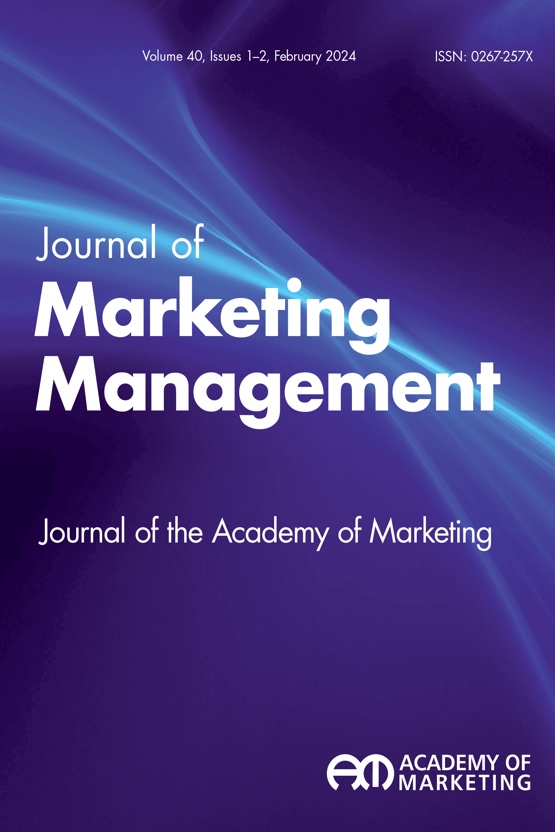Submit a Manuscript to the Journal
Journal of Marketing Management
For a Special Issue on
Model Selection in Marketing Research
Manuscript deadline

Special Issue Editor(s)
Marko Sarstedt,
Ludwig-Maximilians University Munich, Germany and Babeș-Bolyai University, Romania
sarstedt@lmu.de
Francesca Magno,
University of Bergamo, Italy
francesca.magno@unibg.it
Vasilica-Maria Margalina,
CESINE University Center, Spain
vasilicamaria.margalina@campuscesine.com
Fabio Cassia,
University of Verona, Italy
fabio.cassia@univr.it
Christian M. Ringle,
Hamburg University of Technology, Germany and James Cook University, Australia
c.ringle@tuhh.de
Model Selection in Marketing Research
Models simplify reality to reveal key relationships. While they can’t capture all its complexity, their strength lies in clarity and focus. While highlighting meaningful relationships, no single model fully explains a phenomenon. Exploring theoretically plausible alternative models for explaining the phenomenon under study is therefore a crucial step in advancing scientific knowledge in that it promotes transparency and challenges the overreliance on any one framework.
Alternative models typically emerge when considering theories in new contexts with unique variables and effects, or when researchers build conceptual bridges across related streams of inquiry to provide a holistic understanding of the phenomenon. Given a set of alternative models, researchers then try to identify the model that best approximates the data generation process underlying the phenomenon under study. The ability to explain and confirm theories or predict other data is often considered as an indicator of model’s usefulness or quality. Hence, model selection may focus on explanation and confirmation of theoretical models, on their predictive power, or on an integrated combination of both. This distinction also implies fundamental choices about the nature and purpose of the knowledge produced, which are crucial for appropriate model identification, selection, and evaluation. Thus, different methods and criteria have been proposed for model selection in literature. Model selection is a complex process that involves numerous decisions made by researchers, informed by theory, methods, data, and results. This complexity raises some remaining open questions regarding the selection methods that must be used in each research context.
This special issue of Journal of Marketing Management (JMM) focuses on decisions in the model selection process in terms of conceptual lenses, metrics, and best practices of model selection. We consider studies that address key challenges in each step of the model selection process, including model identification, selection, and evaluation. Studies may also explore the philosophical dimensions of model selection, particularly in the context of open science. The special issue is methods-agnostic, and we welcome submissions related, but not limited to structural equation modeling, latent class analysis, and regression-based methods such as necessary condition analysis, as well hybrid or integrated approaches.
Potential topics of interest include:
- Explanatory and predictive model selection process and criteria
- Integrated approaches combining explanatory and predictive goals
- Multimodel inference (e.g., model weights, ensemble models)
- Segmentation and model-based clustering
- Use and interpretation of fit and modification indices
- Search algorithms for model optimization
- Use of control variables and boundary conditions
- Integration of quantitative selection criteria with theoretical judgment
- Conceptual and philosophical concerns related to model selection and multimodel inference
In alignment with contemporary developments in research transparency, we strongly encourage methodological contributions (e.g., with empirical illustrations) that emphasize the principles of open science. Rather than solely focusing on identifying a single “true” model, this issue invites submissions that highlight transparency throughout the model selection process, advocating for thorough documentation, sharing, and justification of modeling decisions to enhance reproducibility and methodological clarity in marketing research.
While we particularly invite submissions from the partial least squares structural equation modeling research community, we welcome contributions from related fields that engage with methodological and conceptual dimensions of model selection. The special issue does not seek empirical applications (except for methods illustrations) since it primarily targets theoretical and methodological contributions rather than empirical applications.
Informal queries regarding guest editors’ expectations or the suitability of specific research topics should be directed to the Special Issue Editors - Please send your questions to all guest editors in a single email.
The full Call for Papers including references can be found at the JMM blog site: https://www.jmmnews.com/model-selection/
Submission Instructions
Authors should submit manuscripts of between 8,000–10,000 words (excluding tables, references, captions, footnotes and endnotes). All submissions must strictly follow the guidelines for the Journal of Marketing Management. Please note the requirements to include a Summary Statement of Contribution, and to place figures and tables at their correct location within the text. Please also read the following guidelines prior to submitting your manuscript:
Use of images: https://authorservices.taylorandfrancis.com/editorial-policies/images-and-figures/
Use of third-party material: https://authorservices.taylorandfrancis.com/publishing-your-research/writing-your-paper/using-third-party-material/
Ethical guidelines: https://authorservices.taylorandfrancis.com/editorial-policies/research-ethics-guidelines-for-arts-humanities-and-social-sciences-journals/
T&F AI Policy https://taylorandfrancis.com/our-policies/ai-policy/
Manuscripts should be submitted online using the T&F Submission Portal. Authors should prepare and upload two versions of their manuscript (only use alpha-numeric characters or underscores in the filename). One should be a complete text, while in the second all document information identifying the author should be removed from the files to allow them to be sent anonymously to referees.
When uploading files authors will be able to define the non-anonymous version as “Manuscript - with author details”, and the anonymous version as “Manuscript - Anonymous”. To submit your manuscript to the Special Issue choose “Research Article” from the Manuscript Type list in the Submission Portal. On the next screen (Manuscript Details), answer ‘yes’ to the question ‘Are you submitting your paper for a specific special issue or article collection?’. A drop-down menu will then appear and you should select the Special Issue Title from this list.

